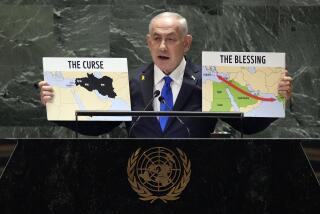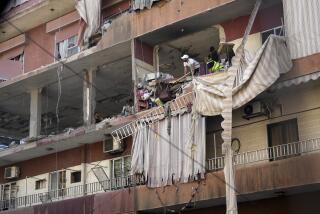Allies Pound Iraqis, Brace for Land War
- Share via
RIYADH, Saudi Arabia — The coalition against Iraq stepped up bombing runs, artillery barrages and reconnaissance patrols Thursday as 700,000 allied troops braced for what U.S. commanders said could be one of the greatest land battles in the history of war.
Speaking before the Soviet announcement of a possible peace agreement, Lt. Gen. Thomas W. Kelly, director of operations for the Joint Chiefs of Staff, told reporters at a Pentagon briefing in Washington that “it will be an intense battle . . . (that will) rank right up there with the best of them.”
“We expect we will have to fight hard to win,” Kelly said. “We will fight hard. We will win.”
The general described U.S. forces arrayed along the border of Kuwait and offshore as “uptight and ready to go.”
In other developments:
Seven American soldiers were killed Thursday when an Army Blackhawk medical evacuation helicopter crashed while attempting to land in Saudi Arabia during bad weather. It was the deadliest noncombat accident since Operation Desert Storm began. Two other Americans were killed when their Army OH-58 scout helicopter crashed while returning from combat operations along the border.
Iraq launched five or six more Scud missiles in attacks on Saudi Arabia and Bahrain, but all of them apparently were downed by Patriot interceptors and there were no reports of damage. In the first attack, the debris from two or three Scuds fell harmlessly into the Saudi desert. In the second, three Scuds were intercepted and destroyed without hitting the diminutive island nation just off the Saudi coast.
The CIA estimated that 10% to 15% of Iraq’s military equipment has been destroyed by allied bombing, a figure well below the Pentagon’s estimate of 35%. Officials said the discrepancy is the result of different tools and philosophies used in assessing the damage, with the CIA numbers representing a “worst-case scenario” from the allied perspective.
The number of American traffic fatalities in Saudi Arabia rose to 34 since August when a soldier died after the truck in which he was riding overturned on a route becoming known as “Suicide Road.” The accident occurred just hours after he had telephoned his family to say he was all right, officials reported Thursday. The driver of the truck, who suffered a broken ankle, said he had swerved to avoid an oncoming Saudi civilian vehicle.
Allied Attacks
The increased activity by allied forces against Saddam Hussein’s forces in Kuwait and southeastern Iraq is “shaping the battlefield” as a prelude to an all-out ground offensive, the allied command said on Thursday.
Seventy-two British artillery pieces and 12 batteries of American rocket launchers blasted away at targets deep in Iraqi-held territory Thursday in one of the heaviest barrages of the war. Damage assessments from these barrages were not immediately available.
Helicopter gunships swept north across the Iraqi frontier to hammer enemy artillery positions, communications centers and armored vehicles with rocket, cannon and machine-gun fire. Five antiaircraft systems, five microwave dishes, two armored personnel carriers, four trucks, two vans and a bunker were destroyed, according to the Pentagon.
Allied patrols crossed the border to gather intelligence about the enemy and return to the bunkers where 421 Iraqi soldiers had been taken prisoner on Wednesday. This time, Gen. Kelly said, 14 more of the enemy were captured, along with a number of small arms.
“They also discovered a locked bunker with some documents in it,” Kelly said. “They may have some intelligence value. We don’t know yet.”
Kelly said that President Bush had not given the order to start a ground war as of midafternoon Thursday, Washington time.
“We have a mission to be prepared to conduct ground operations on order, and that order has not come,” Kelly said. He said that when the order is issued, theater commander Gen. H. Norman Schwarzkopf would be given a “window” within which to choose the most propitious time to launch an attack.
Kelly said the prospective battle, which has been described as a set-piece military operation comparable to the D-Day landing of 1944, would be rapid and intense.
“I wouldn’t say that this will be the toughest battle ever fought in the history of the world, but I would say it would rank right up there with the best of them, and there would be a lot of violence perpetrated, which is what a military force in the field attempts to do,” Kelly said.
The commander of U.S. Marine amphibious forces in the Persian Gulf said he will try to avoid a direct attack on Iraqi fortifications on the beaches of Kuwait in the event of an all-out allied offensive.
“We wouldn’t go straight at anything,” said Maj. Gen. Harry Jenkins, who commands the 17,000-man Marine landing force.
Jenkins said many Iraqi units have been sent to defend Kuwait’s coast against a Marine landing. “We’ve seen more and more of them along the coast,” he told reporters aboard his command ship, the Nassau.
The Iraqi troops have now occupied and fortified numerous civilian buildings, he said, and those buildings, many in urban areas, would be targets for naval gunfire and air strikes before Marines hit the beach.
“If we land in a built-up area, there will be collateral damage, but obviously we do not want to destroy the country,” he said.
Jenkins said options for his men include a full-scale landing, limited operations or even a faked assault to decoy and tie down Iraqi coastal defense troops while other allied forces launch attacks.
He said an amphibious force of about 30 ships moved into the Gulf in the last two weeks after conducting major exercises to prepare for a possible landing in Kuwait.
A U.S. Marine general in Riyadh said Thursday that the Iraqi front lines are loaded with troops who are little more than ill-prepared cannon fodder.
“I think what we’re seeing is that in (Hussein’s) rush to get more forces in the Kuwait theater of operations, he ill-prepared and ill-armed some of these folks,” said Marine Brig. Gen. Richard I. Neal.
Another military source concurred: “There are places on the battlefront that are clearly a joke,” he said, but he also contended that there are “at least 10 divisions out there who want to fight.”
Kelly said that with more than 2,200 of their soldiers now being held prisoner of war by the allies, Hussein’s commanders are becoming increasingly concerned about troop desertions.
He said Iraqi soldiers are now being required to sign an oath that says, “I will not desert.”
U.S. Aircraft Losses
The crash of the UH-60 medical evacuation helicopter claimed the lives of all four crewmen and three passengers, according to allied military officials. None of the victims were identified.
While the command provided few details about the incident, which occurred just before dawn on Thursday, sources said the crash occurred in an area hit frequently in recent days by shamals, or sandstorms.
These sandstorms, common at this time of year, can foul equipment with abrasive grit and reduce visibility to near zero.
No details were given about the crash of the other helicopter, an OH-58, which claimed two lives, and the names of the victims were not released.
Two other American aircraft were lost, according to the allied command.
An Air Force F-16 fighter-bomber crashed after suffering engine failure while being refueled in flight, and a Marine CH-46 helicopter was wrecked in an emergency landing. The F-16 pilot ejected and was rescued. One crewman aboard the helicopter suffered a broken leg, the command said.
Damage Estimates
The CIA’s estimate that 10% to 15% of Iraq’s military hardware has been destroyed by allied bombing is based on photographs from reconnaissance planes and spy satellites and on intercepted enemy communications, officials said.
The Pentagon figure of 35%, provided by the Central Command in Saudi Arabia, is based on aerial reconnaissance data, pilot reports, prisoner-of-war interrogations and information gathered through ground reconnaissance patrols.
At Central Command, “they’re looking at more data,” said an official familiar with the process of bomb-damage assessment. “The numbers aren’t, and shouldn’t be, comparable.”
“The question is to what degree (Central Command) discounts pilot enthusiasm,” said another source, Jeffrey Richelson, an expert on spy satellites and aerial reconnaissance. “Pilots aren’t there when the smoke clears. Satellites are.”
However, Howard Teicher, former director of Middle Eastern affairs with the National Security Council, said the Central Command probably has the better overall picture.
“They’re the ones whose lives are on the line,” Teicher said. “The whole world is watching. It’s not like the jungles of Vietnam,” where the Pentagon provided vastly inflated assessments of battle damage sustained by North Vietnamese forces.
A third source of bomb-damage assessment, Israeli intelligence, estimates that 20% to 25% of Hussein’s weaponry has been destroyed, figures squarely in the middle of those provided by the CIA and the Pentagon.
“We only consider reports of targets killed,” said an Israeli source. “They (the U.S. analysts) also take into account targets hit.”
Financing the War
House Speaker Thomas S. Foley (D-Wash.) said the Bush Administration will ask Congress today to approve about $50 billion in supplemental appropriations to pay for Persian Gulf military operations during the first three months of the year.
Meanwhile, the House voted 393 to 1 to require the Administration to report monthly on the cost of the Gulf War as well as the amount of contributions received from Japan, Germany, Saudi Arabia and other countries to offset outlays by the United States.
Times staff writer Bob Drogin in Dhahran, Saudi Arabia, contributed to this report.
DESERTIONS
In the U.S. military briefings on Thursday, there was discussion of desertion by Iraqi forces. According to Marine Brig. Gen. Richard I. Neal:
Reports from some of the enemy prisoners of war indicate that their commanding officers are being held directly accountable for desertions.
The commanders are being forced to sign something called a “document of oath,” making them responsible for any of their troops who desert.
At the same time, the troops are also being forced to sign a document in which they promise not to desert.
IRAQI FIELD BUNKER
At his briefing Thursday, Brig. Gen. Richard Neal discussed the type of bunker used by the 421 Iraqi troops captured the day before. He made these points: PURPOSE: Combination “fighting hole/bunker/living space.” DIMENSIONS: About 5 feet by 10 feet dug into the ground and supported with beams. ROOF: Corrugated tin covered in sand
The corrugated tin and sand are thought to be an attempt to camouflage the bunker rather than to provide overhead protection. The construction, according to Brig. Gen. Neal, “was less than to be desired.”
More to Read
Sign up for Essential California
The most important California stories and recommendations in your inbox every morning.
You may occasionally receive promotional content from the Los Angeles Times.










